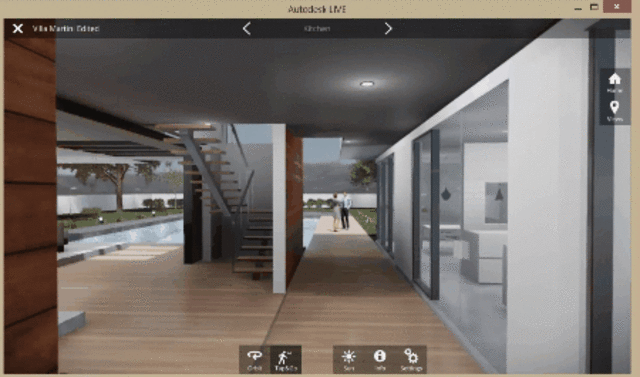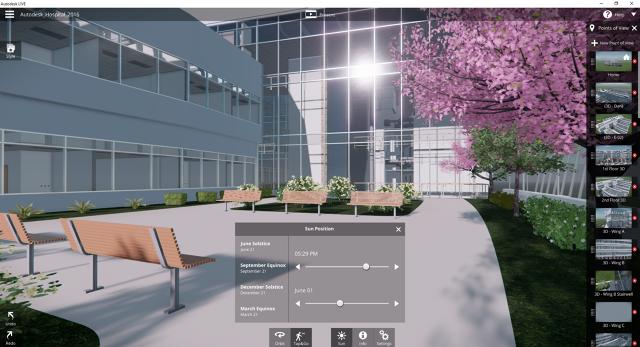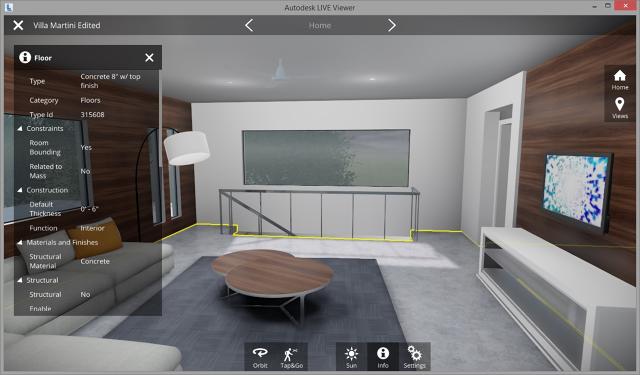While trying to design a set of high-end homes, Frank Wolbertus and his colleagues at TBI-KennisLab had an idea.
Wolbertus had been testing a tool from Autodesk that within minutes could turn building designs into video game-like 3D worlds. Wouldn’t it be nice if TBI—one of the largest building companies in the Netherlands—could share those walk throughs with the home-buyers? Although the tool was still in development and under a non-disclosure agreement, Autodesk gave the go-ahead. And before long, the buyers were changing the layout of their future home based on what they’d seen in the simulations.
Seven months later, Autodesk is releasing that tool, dubbed “Autodesk Live.” By helping people visualize the space that architects have created, the hope is that it will change the building design process.

Click To View
Autodesk Live is a $30 per month add on within Revit, the company’s popular building-design program. By pressing one button, designers can create an interactive scene that’s sort of like a first-person computer game. (Incidentally, Autodesk Live makes use of Stingray, a 3D game engine the company announced last year.) Doors open and close as the user steps through. Sunlight and shadows are accurate to the time of day and geographic location. Designers can even define the height of the user’s head, which swivels gently as it climbs up stairs and turns corners.
“It will give you a real sense of what it will feel like to walk around and basically live in that building or the that house in the future—before it’s built,” says Nicolas Fonta, Autodesk Live’s senior product manager.
Interactive models aren’t a new concept in the building-design world, but Autodesk argues that its solution is the simplest. Once the designer presses the “Go LIVE” button in Revit, Autodesk uploads the model to its servers, performs some processing in the cloud, and spits out an interactive file a few minutes later. Designers can then tweak visual settings in a separate Live Editor application before passing it on to clients, who can walk through the model using a Live Viewer app for Windows PCs and iPads.

“Next-generation consumers are going to expect this, and we need to make it easier for designers to participate, and we need to make it more accessible for them,” says Angi Izzi, Autodesk’s global industry strategy and business manager.
Wolbertus, TBI-KennisLab’s developer and building information modeling expert, agrees that there’s nothing similar on the market, and he’s tried a lot of alternatives. Lumion3D can convert designs from Revit and other programs into virtual worlds, he says, but the program is expensive, and making a good-looking model takes much more time. A web-based application called Clever is useful for visualizing large-scale models, but viewing a single, detail-rich building requires substantial processing power on the client’s PC. Wolburtus also tried another visualization program called Revizto, but found it time-consuming and difficult to navigate.
Besides, he says, having a one-button solution within Revit means the company’s modelers don’t have to waste time learning new technical skills.
“They have it difficult enough at the moment to make good models, so we don’t want to add extra burden on them to do stuff that’s not their core business,” Wolburtus says.
With Autodesk Live, TBI-KennisLab furnished home-buyers with iPads and had them propose changes to internal wall layouts, location of doors, the position of the master bedroom, and even the distribution of wall outlets. The company’s technical advisers then met with those customers to talk about what was technically possible, and to make changes on the spot.
“Customers don’t think about sockets and outlets. They’re thinking where the furniture should be, and the TV should be,” Wolburtus says. “So the technical guy is telling them how many sockets they have left in their budget, and they give some advice about what previous customers did. Together they changed the house.”

Going Virtual
For Autodesk, the next step is to add more ways to view Live walk throughs. The company is especially jazzed about virtual reality, and has been testing the Oculus Rift and HTC Vive headsets support with beta users.
“We’re super excited about the results that we’re getting, and the goal, very very short-term … is click one button, and just put the headset on your head, and you start experiencing the model in VR,” says Fonta.
Strangely, the company isn’t yet committing to simpler and much more economical VR solutions such as Google Cardboard and Samsung Gear VR, even though these devices might be better suited to the notion of easy access that Autodesk is pushing. As Wolbertus notes, TBI-KennisLab has used other software to experiment with Oculus demos, but customers couldn’t take those walk throughs home with them, and were often too distracted by the technology to focus on the actual design. (Fonta says Autodesk will “see what other devices become adopted in the industry” in the long-term, but for now the company is only developing non-VR Live Viewer apps for iPhone and Android.)
In any case, Autodesk eventually sees VR as the gateway to other design applications for Autodesk Live, beyond just architecture. For instance, engineers could use a VR headset to get a close look at pipe flow, and construction companies could use VR to understand the building process. VR is already starting to reshape all kinds of industries, and it seems Autodesk doesn’t want to sleep through the trend.
“Today, we start with architecture, because that’s really who today produces the visualization,” Autodesk’s Angi Izzi says, “but tomorrow, the sky’s the limit.”
Fast Company , Read Full Story
(31)